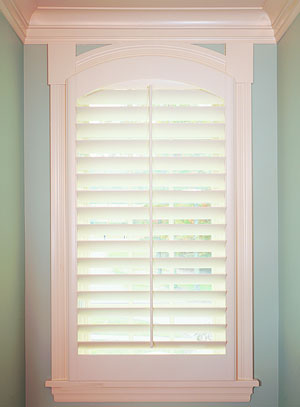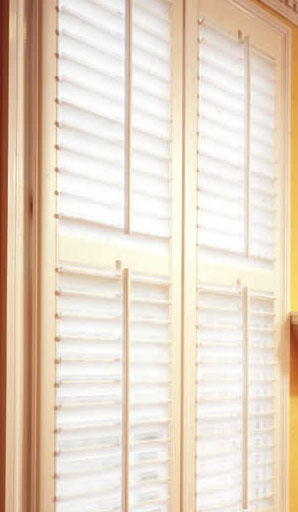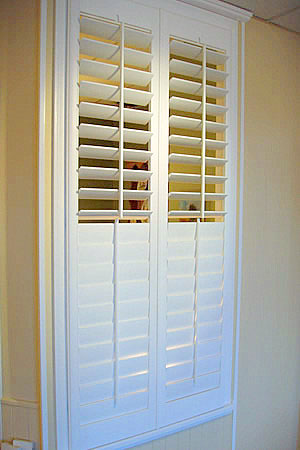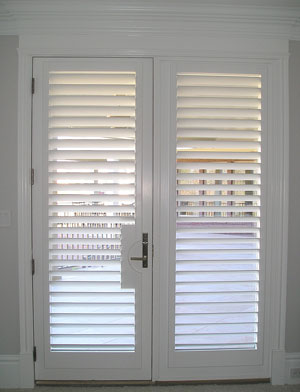The “traditional” plantation shutter has been around for hundreds of years with remarkably few modifications. Appreciated for centuries in open, breezy homes of the Caribbean and stately homes of the Old South, shutters were originally used in windows before glass to protect homes from the elements and pests. With the high standards set long ago, the plantation shutter has been able to transcend its original setting and lend beauty and ambiance to a wide variety of today’s home décors.
The “traditional” shutter is usually what comes to mind when one begins to contemplate a shutter purchase. Most often a full length, or “single hung” panel, this shutter typically includes one set of panels that goes from the bottom to the top of a window. Considered the “grandfather” of plantation shutters, the design is quite simple, with a clean, elegant appeal.
A “café shutter” treatment covers only the lower portion of the window, lending a more casual air to your surroundings. A decorative fabric valance usually graces the top of the window.
Both the single hung panel and the café shutter are available with a wide variety of options including tilt rod, louver size and shape, and finish options.
Plantation Shutter Tilt Rod Options
A shutter’s tilt rod is the mechanism that controls the movement of the louvers. Usually placed in the center of the panel, this wooden rod allows the simultaneous movement of each attached louver.
is one continuous rod that attaches all louvers from the top to the bottom of a panel.
can be added to a panel allowing control of the upper and lower sets of louvers independently. This application is particularly useful if you enjoy the privacy provided by the closed lower louvers, but don’t want to sacrifice the natural light provided by the open upper louvers.
offers the same independent control of the upper and lower louvers as the divider rail but does not include the “rail” that separates the upper and lower tiers.
option is also available for those who prefer a more contemporary look. A small tilt rod is discreetly hidden behind the panel to allow full functionality of the shutter’s louvers.
Plantation Shutter Louver Options
The louvers in a shutter are the movable “parallel slats” that can be adjusted to vary the amount of light that is allowed into a room.
At Shenandoah Shutters, we offer three options for louver size and two options for louver shape.
Plantation Shutter Louver Sizes
Our plantation shutters are available in 2 1/2”, 3 1/2” and 4 1/2” louver sizes. Which louver size you choose is completely a matter of taste. There is no specific advantage to one size louver versus another. The only significant difference to note is that a larger louver size will result in a larger space between each individual louver when open.
Plantation Shutter Louver Shapes
Our louvers are available in two different shapes – flat and contour. The flat louver, as its name suggests, has a flat top and bottom. The contoured louver is most easily described as resembling the wings of an airplane – slightly wider in the middle and tapered towards the front and back. Again, which louver shape you choose is entirely a matter of taste – both are equally beautiful.
Plantation Shutter Finishes
Seeing and touching is believing…
Solid wood construction AND a beautiful silken finish – the same qualities you look for and expect in fine furnishings. These two elements are also features of the finest all-wood plantation shutters. While there are a number of different types of wood available, the most important ingredient is not the kind of wood, but its quality and how it is cut, sanded and finished. At Shenandoah Shutters, every shutter is finished by hand. We realize hand-sanding is the only way to achieve the smooth lacquered finish desired in finer homes. Ultimately, the proof is in the finished shutter. Let your eye be the judge.
Whether you’re interested in our many standard shades of white, custom paint, custom stain or solid cherry or oak to match your molding, our design consultants have the answers.
Click here to see Locations we serve in Virginia, Maryland, and Washington, D.C. If you don’t see your area, please do not hesitate to call us!




